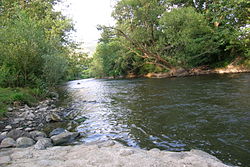Studenica (river)
| Studenica (Студеница) | |
|---|---|
 Studenica river near Ušće | |
| Location | |
| Country | Serbia |
| Physical characteristics | |
| Source | |
| • location | Golija mountain, Serbia (as the Crna reka) |
| • elevation | 1,615 m (5,299 ft) |
• coordinates | 43°28′09″N 20°37′09″E / 43.4692°N 20.6192°E |
| Length | 60 km (37 mi)[1] |
| Basin size | 582 km2 (225 sq mi) |
| Basin features | |
| Progression | Ibar→ West Morava→ Great Morava→ Danube→ Black Sea |
The Studenica (Serbian: Студеница, pronounced [studɛ̌nitsa]) is a river in southwestern Serbia, a 60 km-long left tributary to the Ibar river.[1]
Origin
The Studenica originates from the central section of the northern slopes of the Golija mountain, as the Crna reka (Crna River, "Black River"), at an altitude of 1,615 m. The river flows northward, parallel to the flow of the Brusnička reka (Brusnička River, "Brusnik River"), next to the villages of Crna Reka, Koritnik, Ratari and Pločnik. Between the villages of Devič and Čečina, the Crna Reka and Brusnička reka meet and continue to the north under the name of Studenica.
Valley
The Studenica carved a long and deep gorge-like valley, characterized by the arc-shaped stretching in the west–east direction, between the Radočelo (on the south) and Čemerno (on the north) mountains. The villages of Usilje, Pridvorica, Mizdraci, Mlanča and Miliće are located in the valley, so as the Isposnica Monastery and the cave on Čemerno mountain.
The Čemerno mountain was a game hunting area from the Medieval period, with Saint Sava writing about his father, Stefan Nemanja, hunting on the mountain, and deciding to build Studenica Monastery there. The main game species was European deer, but due to the overhunting, both legal and illegal, the last deer was killed in 1962. In the late 2020, 33 stags and hinds were reintroduced in an 5.2 ha (13 acres) asylum. A year later further 30 animals were released, and by June 2023 there were over 100 deer spreading along the mountain's localities Ponore and Savovo. The reintroduction program was finished in July 2023 with addition of further 11 animals. The hunting will be allowed when the number of deer crosses 200 animals.[2]
The most important feature in the entire Studenica valley is the
The Studenica belongs to the Black Sea drainage basin, drains an area of 582 km2 itself, and it is not navigable.
The name of the river, Studenica, in Serbian means cold water.
Controversy
In the valley, the river has a huge hydro electrical potential, but none is used so far. In the late 1980s and early 1990s government strongly pushed a project of damming the river and building a powerful hydro electrical power plant with the artificial lake. After the public outcry and protests from the Serbian Orthodox Church that the artificial lake would damage the monastery the idea was finally dropped.
In the late 2010s, construction of
See also
- Rivers in Serbia
References
- ^ ISSN 0354-4206. Retrieved 30 May 2018.
- ^ Miroljub Dugalić (22 June 2023). Повратак јелена у немањичко ловиште [Deer returns to Nemanjić's hunting ground]. Politika (in Serbian). p. 14.
- ^ Višnja Aranđelović (1 July 2020). МХЕ у поплавама прептрпеле, али и нанеле штету [Micro hydros both sustained and caused harm]. Politika (in Serbian). p. 8.
- Mala Prosvetina Enciklopedija, Third edition (1985); Prosveta; ISBN 86-07-00001-2
- Jovan Đ. Marković (1990): Enciklopedijski geografski leksikon Jugoslavije; Svjetlost-Sarajevo; ISBN 86-01-02651-6
